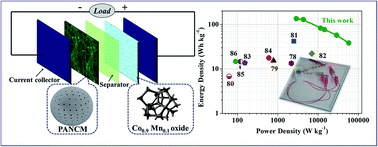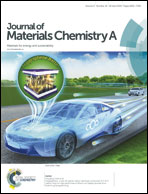Large scale production of polyacrylonitrile-based porous carbon nanospheres for asymmetric supercapacitors†
Abstract
The increasing demand for a satisfactory combination of energy–power features in supercapacitors has triggered considerable research efforts dedicated to the development of high-efficiency energy storage devices. In our study, highly cross-linked porous carbon microspheres were prepared via the carbonization of as-prepared polymer spheres followed by a KOH activation process. The resultant products exhibited a high maximum specific surface area (3065.6 m2 g−1), rich nitrogen and oxygen doping (22.3 wt%) and a significant volume fraction of mesopores/macropores (37.91%). The optimal electrode presents the highest specific capacitance of 290 F g−1 and superior cycling stability with 96% retention after 3000 cycles in an aqueous 2 M KOH electrolyte. Moreover, the assembled asymmetric supercapacitor device based on Co0.9Mn0.1 arrays as the positive electrode achieves a specific capacitance of 105.43 F g−1 and an energy density of 134.9 W h kg−1 at a power density of 2879.8 W kg−1. Interestingly, the device can illuminate an LED for 30 min, demonstrating the promising application potential in high-performance devices related to energy storage.



 Please wait while we load your content...
Please wait while we load your content...